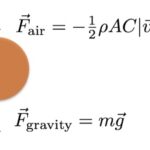Two students are discussing their physics homework prior to class. They are discussing an object that is being acted upon by two individual forces (both in a vertical direction); the free-body diagram for the particular object is shown at the right. During the discussion, Anna Litical suggests to Noah Formula that the object under discussion could be moving. In fact, Anna suggests that if friction and air resistance could be ignored (because of their negligible size), the object could be moving in a horizontal direction. According to Anna, an object experiencing forces as described at the right could be experiencing a horizontal motion as described below.

Noah Formula objects, arguing that the object could not have any horizontal motion if there are only vertical forces acting upon it. Noah claims that the object must be at rest, perhaps on a table or floor. After all, says Noah, an object experiencing a balance of forces will be at rest. Who do you agree with?
See Answer
Remember last winter when you went sledding down the hill and across the level surface at the local park? (Apologies are extended to those who live in warmer winter climates.)

 Imagine a the moment that there was no friction along the level surface from point B to point C and that there was no air resistance to impede your motion. How far would your sled travel? And what would its motion be like? Most students I’ve talked to quickly answer: the sled would travel forever at constant speed. Without friction or air resistance to slow it down, the sled would continue in motion with the same speed and in the same direction. The forces acting upon the sled from point B to point C would be the normal force (the snow pushes up on the sled) and the gravity force (see diagram at right). These forces are balanced and since the sled is already in motion at point B it will continue in motion with the same speed and direction. So, as in the case of the sled and as in the case of the object that Noah and Anna are discussing, an object can be moving to the right even if the only forces acting upon the object are vertical forces. Forces do not cause motion; forces cause accelerations.
Imagine a the moment that there was no friction along the level surface from point B to point C and that there was no air resistance to impede your motion. How far would your sled travel? And what would its motion be like? Most students I’ve talked to quickly answer: the sled would travel forever at constant speed. Without friction or air resistance to slow it down, the sled would continue in motion with the same speed and in the same direction. The forces acting upon the sled from point B to point C would be the normal force (the snow pushes up on the sled) and the gravity force (see diagram at right). These forces are balanced and since the sled is already in motion at point B it will continue in motion with the same speed and direction. So, as in the case of the sled and as in the case of the object that Noah and Anna are discussing, an object can be moving to the right even if the only forces acting upon the object are vertical forces. Forces do not cause motion; forces cause accelerations.
Newton’s First Law – Revisited
Newton’s first law of motion declares that a force is not needed to keep an object in motion. Slide a book across a table and watch it slide to a rest position. The book in motion on the table top does not come to a rest position because of the absence of a force; rather it is the presence of a force – that force being the force of friction – that brings the book to a rest position. In the absence of a force of friction, the book would continue in motion with the same speed and direction – forever (or at least to the end of the table top)! A force is not required to keep a moving book in motion; and a force is not required to keep a moving sled in motion; and a force is not required to keep any object horizontally moving object in motion. To read more about this misconception, return to an earlier lesson.



